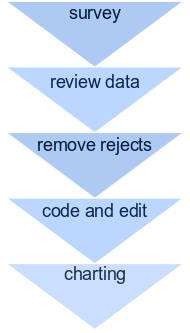Rethinking Questionnaires - Live data charting
Continuing our series on Rethinking Questionnaires, this demonstration is a preliminary warm-up to support our next discussion looking at using questionnaire techniques to develop the reporting process.
We're calling it a warm-up because, although we assume that most researchers use live data reporting - that is turning survey data into a chart set for analysis and presentation straight from the data, we do know some survey packages only create tables, and others only create charts one-by-one and not slide sets. The aim of this pre-demonstration is to establish a shared perspective on current reporting methods before we look more deeply at new ideas around reporting.
Here we're using YouGov data  captured before in May 2016, just before the Brexit vote, as it has to extremely interesting response data which we will focus on next time. The charts are 'live' - that is they are driven directly by survey data. That means we can set a filter and update the whole chart set, or click to see drill-down charts and do things like sort and filter the data.
captured before in May 2016, just before the Brexit vote, as it has to extremely interesting response data which we will focus on next time. The charts are 'live' - that is they are driven directly by survey data. That means we can set a filter and update the whole chart set, or click to see drill-down charts and do things like sort and filter the data.
Click our logo for the next slide
The charting process
 With live data charting, researchers have tools to manage respondent quality checks, data edits and open-ended coding. Charts then draw directly from
original survey questions, but include summary lines, aggregated charts or other calculations, take-out text, and obviously text slides like this one.
With live data charting, researchers have tools to manage respondent quality checks, data edits and open-ended coding. Charts then draw directly from
original survey questions, but include summary lines, aggregated charts or other calculations, take-out text, and obviously text slides like this one.
Charting is web-based and can drive sophisticated charting tools like d3. Data can be exported to SPSS or R, and chart sets printed to .pdf or exported to Excel or Powerpoint. And tables can also be generated on the fly (see here) .
.
As the data is live, we can add filters and have the whole dataset instantly updated. For instance, filter the data by Male  or Female
or Female  .
.
In practice, we normally present straight from the live slide set. If required the charts can be set up with a full animated Prezi style display.
Click our logo for the next slide
The data source
The dataset for this presentation is taken from YouGov data  in connection with the UK Brexit vote. The data actually comes from May 2016 prior to the vote as part of the pre-referendum polling. 2969 respondents were interviewed across the UK by phone and online.
in connection with the UK Brexit vote. The data actually comes from May 2016 prior to the vote as part of the pre-referendum polling. 2969 respondents were interviewed across the UK by phone and online.
Opinion polling is struggling to predict the outcome of popular votes and elections, and we'll show a little more on this in the next demonstration. Here we'll show voting intention per party and for the referendum from the Yougov data, before looking at a couple of interesting questions about response rates.
The data we show are unweighted.
Click our logo for the chart on voting intention...
Voting intention May 2016
All
South
London
Midlands
North
Scotland
Wales
Close this text box to see the slide...
EU referendum preference
All
South
London
Midlands
North
Scotland
Wales
Close this text box to access the chart...
State of the world
Immigration view
Response rates
The charts we will want to draw attention to for next time are the two following on likelihood to answer the phone and likelihood to take a call on a mobile.
In the next demonstration we'll run some calculations to show how propensity to answer can cause problems with response rates and representativeness within samples.
You might want to think about how this might affect telephone research for next time...
Phone answering - landline
All
South
London
Midlands
North
Scotland
Wales
Phone answering - mobile
All
South
London
Midlands
North
Scotland
Wales
Age and Gender
All
Summary
This concludes our brief warm-up demonstration of live charting.
In the main Rethinking Questionnaire demonstration that will follow, we will move this much further to look at how Questionnaire techniques can be blended with charts and results and automated summaries to improve the reporting and communication process.
You can follow our full set of demonstrations on Rethinking Questionnaires  at our website, or via LinkedIn
at our website, or via LinkedIn  .
.
